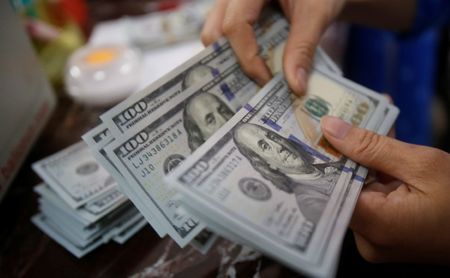Forex
Dollar slips ahead of GDP data; euro rises and yen surges

Investing.com – The U.S. dollar slipped lower Thursday, the euro posted small gains while the Japanese yen climbed to multi-month highs ahead of next week’s Bank of Japan meeting.
At 05:25 ET (09:25 GMT), the Dollar Index, which tracks the greenback against a basket of six other currencies, fell 0.2% to 103.950, extending an overnight decline.
Dollar slips ahead of GDP data
The dollar retreated Thursday, extending an overnight decline amid increasing confidence that the will cut interest rates in September.
data for the second quarter are due later in the session, and is expected to show annualized growth of 2.0%.
This would be above the 1.4% growth seen in the first quarter, but would remain considerably slower than the 4.2% pace seen in the second half of last year.
The release will also show inflation slowed considerably last quarter, with the GDP price index falling to 2.6% from 3.1%, ahead of Friday’s price index data, the Federal Reserve’s favored gauge of inflation.
The Fed is set to meet next week, and is widely to keep interest rates steady while signaling a rate cut in September.
German business morale falls again
In Europe, rose 0.1% to 1.0847, with the euro edging higher despite German business morale unexpectedly falling in July, the third consecutive decline in Germany’s most prominent leading indicator..
The Ifo institute said its sank to 87.0 in July from 88.6 in June.
“The German economy is stuck in the crisis,” said Ifo president Clemens Fuest.
The kept interest rates on hold at 3.75% last week, but markets are pricing in just short of two more ECB rate cuts for the rest of this year.
traded 0.2% lower at 1.2885, falling back from the 1.30 level ahead of next week’s Bank of England policy-setting meeting.
UBS expects the central bank to trim interest rates in what is widely seen as a close call as to when it will start what is likely to be a slow and steady reduction path.
Yen goes from strength to strength
In Asia, fell 0.7% to 152.72, with the pair falling to its weakest level in 2-1/2 months as traders abandoned short yen bets in the run up to the BOJ’s July meeting in the wake of suspected currency market intervention by the Japanese government.
The is expected to consider a 10 basis point hike, and could unveil a plan to roughly halve bond purchases in coming years.
“USD/JPY has now corrected 6% off its high. This has proved another successful intervention campaign for Japanese authorities,” said analysts at ING, in a note.
“We think the success of the intervention has had less to do with the size of the FX sales and more to do with the timing. As was the case in September/October 2022, Japanese FX intervention has been timed to coincide with a dovish reappraisal of Fed policy. Very clever.”
slipped 0.5% lower to 7.2281, but remained near an eight-month high amid persistent concerns over a slowing economic recovery in the country. Surprise rate cuts by the People’s Bank added to pressure on the currency and did little to lift spirits over the Chinese economy.

 Forex3 years ago
Forex3 years agoForex Today: the dollar is gaining strength amid gloomy sentiment at the start of the Fed’s week

 Forex3 years ago
Forex3 years agoUnbiased review of Pocket Option broker

 Forex3 years ago
Forex3 years agoDollar to pound sterling exchange rate today: Pound plummeted to its lowest since 1985

 Forex3 years ago
Forex3 years agoHow is the Australian dollar doing today?

 Cryptocurrency3 years ago
Cryptocurrency3 years agoWhat happened in the crypto market – current events today

 World3 years ago
World3 years agoWhy are modern video games an art form?

 Commodities3 years ago
Commodities3 years agoCopper continues to fall in price on expectations of lower demand in China

 Economy3 years ago
Economy3 years agoCrude oil tankers double in price due to EU anti-Russian sanctions


























